1800 - 1900
- Extraordinary chemist (1800)
- Imperial University (1812)
- State College (1815)
- The oldest student fraternity (2 February 1815)
- Stratingh's electrical vehicle (1835)
- A new Academy building (1846)
- Aletta Jacobs (1871)
- A close call for the University (1876)
- Jacobus Cornelis Kapteyn (1877)
- Charlotte Jacobs (8 October 1877)
- Gerard Heymans (1892)
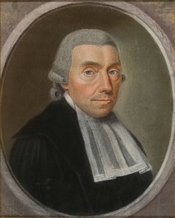
1800: Extraordinary chemist
Professor of chemstry Petrus Driessen (1753-1828) was a man with exceptional ideas for his age. The modern slogan 'there's no such thing as waste', used by present-day waste disposal companies, could well have been Driessen's motto. Around 1800, he was already concerned with sustainibility and waste processing.
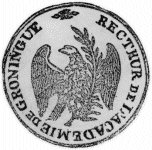
1812: Imperial University
As a result of the French occupation of the Netherlands, the University was administered by the French and coupled (together with the University of Leiden) to the Imperial University in Paris. Initially, the French only wanted to maintain one university in the Netherlands (Leiden), but, upon visiting Groningen, an inspection committee noted the vast traveling distance between the two cities. Since the French were charmed by the city, the university remained open and was renamed the Imperial University in Groningen.
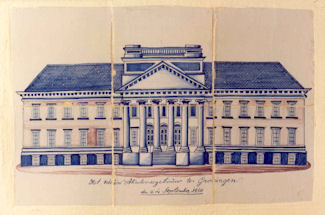
1815: 'Rijkshogeschool' (State College)
The founding of the 'Kingdom of the Netherlands' saw the Imperial university of Groningen being changed into a Rijkshogeschool (State college). The faculty of Philosophy was split up into faculties for Arts and Philosophy, and Mathematics and Physics. The future of the university at this time was still unsure, despite increasing numbers of enrolled students, the number still remained under 200.
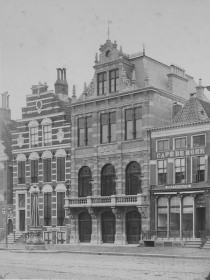
2 February 1815: The oldest student fraternity
At the start of the 19th century, the university board and a growing number of students were dissatisfied with the hazing practices, which focused mainly on power and money. In the more civilian society following the French Revolution, students strived to create an environment with a significant emphasis on academic knowledge. In order to achieve this environment, students founded Vindicat atque Polit, today the oldest student fraternity in the Netherlands, and its society Mutua Fides (Mutual Trust).
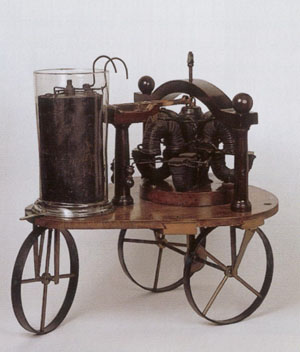
1835: Stratingh's electrical vehicle
Sibrandus Stratingh (1785-1841), a professor of Chemistry and Technology, was the first person to drive a car in the Netherlands, when he took his steam-driven carriage to the streets in 1834. The Dutch king, William I, was impressed and gave Stratingh a stipend of 600 guilders to carry out further experiments. In 1835, Stratingh built a small electric car, driven by a large battery. In this video, you'll learn more about Sibrandus Stratingh and his vehicle.
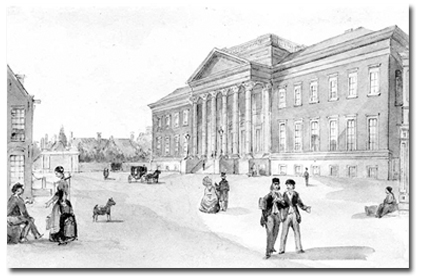
1846: A new Academy building
The cloister, which functioned as the Academic Building, was torn down in 1846. The construction of a new, neo-classic, Academic Building was completed on the same site four years later. The upper floor of this building contained a Museum of Natural History with exhibits including stuffed birds, skeletons and various body parts in formaldehyde. The picture on the left gives a good indication of the design of the Academy building. It must have been a joy to study in such a beautiful building!
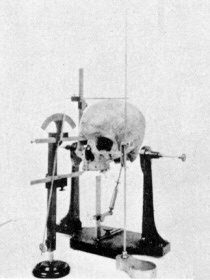
1850: Een Friese schedel
Verschillen Friezen van Groningers? Rond 1850 werden in Friesland en Groningen veel wierden en terpen, bronnen van humusrijke aarde, commercieel afgegraven. Hierbij kwamen veel interessante prehistorische voorwerpen tevoorschijn die het archeologisch onderzoek in Friesland en Groningen aanwakkerden. Zo ook bij Arend Folmer, huisarts te Eenrum, die zich na het lezen van een antropologisch artikel over schedelomvang ontpopte tot een hartstochtelijk schedelmeter. Hij verzamelde schedels uit oude wierden om zo de verschillen tussen de ‘oude’ en ‘nieuwe’ Friezen aan te tonen. Folmer had vooral aardigheid aan het meten en beschrijven van de schedels. Zijn resultaten bleven erg vaag. Desondanks kan de amateur-antropoloog hier wel mee aangeduid worden als de eerste Groninger archeoloog.
Periode: 1 januari 1850
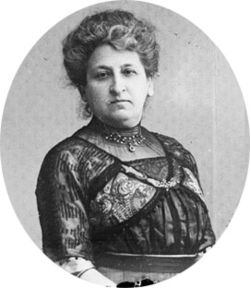
1871: Aletta Jacobs
Aletta Jacobs was the first female student to be admitted to a Dutch university. This happened in Groningen, where she became a medical student. This is no coincidence, because of the university's progressive character. For good reason, professors often spoke of the 'radical north'. Aletta Jacobs completed her studies in medicine and graduated in 1878. One year later, in 1879, she even obtained her doctorate. She became an internationally renowned fighter for women's rights. Watch this recently discovered footage of Aletta Jacobs.

1876: A close call for the University
For a considerable time, actually since the educational reform in 1848, the university of Groningen was threatened with closure. In 1876, the Dutch Parliament discussed a new Law on Higher Education. A majority in the Parliament wanted to retain only two universities: Leiden and Utrecht. However, Groningen stroke a bargain with the city of Amsterdam, that advocated for a university of its own. The proponents of the two cities merged, resulting in a political majority which ensured the university to be able to remain open. The result was four universities instead of two.
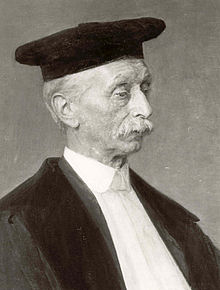
1877: Jacobus Cornelis Kapteyn
This video presents an insight in the life and works of Jacobus Cornelis Kapteyn (1851-1922), who was appointed professor of astronomy and theoretical mechanics at the university of Groningen in 1877. Upon his appointment, however, there was one small problem. The university did not have an observatory, through which Kapteyn was not able to make the observations he desired. Kapteyn made a virtue out of necessity by devising the concept of an astronomical laboratory, in which he conducted research on the basis of observations by other astronomers. In this way, he became the founding father of Dutch astronomy and enjoyed great international respect.
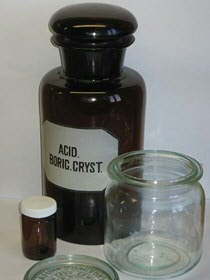
8 October 1877: Charlotte Jacobs
Aletta Jacobs was the first female student in the Netherlands. It is less well known that her sister, Chalotte Jacobs, became the second female student. In 1877, she started her studies in pharmacology at the Groningen university. In 1881 she obtained her degree at the University of Amsterdam. After having worked as a pharmacist at the Utrecht hostpital, she traveled to Batavia where in 1887 she opened her own pharmacy. Jacobs became the first female pharmacist in the Dutch East Indies and because of her emancipatory beliefs only appointed female assistants. In 1912 she returned to the Netherlands where she fulfilled a key role in the Dutch women’s movement.
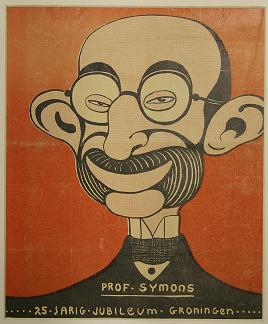
1881: Barend Symons
In 1881 wordt Barend Symons benoemd tot hoogleraar Hoogduitsche taal- en letterkunde. Symons was in 1878 naar Groningen gekomen om daar als eerste privaatdocent aan een universiteit Duits te onderwijzen. Ondanks dat Duits toen nog geen academische studie was (dat gebeurt pas in 1921), was er veel (vooral vrouwelijke) belangstelling voor zijn lessen en grepen vele de mogelijkheid aan om hun lesbevoegdheid (MO-akte) Duits te halen. Na zijn aanstelling als hoogleraar, worden er al spoedig ook leerstoelen opgericht voor de Franse (1884 – A.G. van Hamel) en Engelse (1885 – J. Beckering Vinckers) taal- en letterkunde. Groningen loopt voorop met de hoogleraren en lectoren moderne talen, want pas in 1913 volgt Amsterdam.
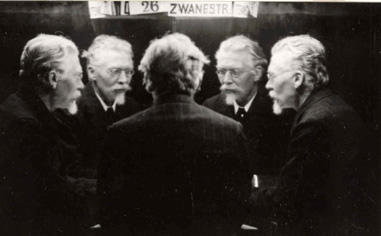
1892: Gerard Heymans
Gerard Heymans (1857-1930) started the first psychological laboratory of the Netherlands. In 1892 he began experimenting in a villa near the present Groninger Museum. Heymans was a champion of th empirical method. In 1909, when the Academy building was rebuilt, he set up a bigger, professional laboratory. This passionate administrator, psychologist and philosopher fulfilled a key role at the university. This video presents an insight into his life.
More news
-
15 September 2025
Successful visit to the UG by Rector of Institut Teknologi Bandung

